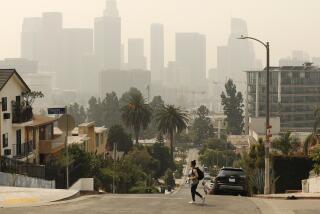EPA Cites Indoor Pollution Hazards
- Share via
WASHINGTON — The air within public buildings may be more than 100 times as polluted as the outdoor air in large industrial cities, according to a report released Thursday by the federal Environmental Protection Agency.
The EPA’s five-year study of 10 large buildings found that elevated levels of dangerous pollutants are especially acute in new buildings and in smoking sections. In four of the buildings studied, the report found more than 500 different pollutants emanating from such building materials as paints, caulking, molding, linoleum tile and carpet.
‘Substantial Portion of Exposure’
“These findings provide strong evidence that indoor contaminants represent a substantial portion of our exposure to air pollution,” the EPA’s acting assistant administrator for research and development, Erich Bretthauer, said.
Low levels of indoor pollutants may be the cause of “sick building syndrome,” in which workers in a new or poorly ventilated building experience eye, nose and throat irritation; headaches; lethargy, and difficulty in concentrating, the report states. Prolonged exposure to some pollutants could result in cancer or other chronic health problems, it states.
The study monitored emissions from building materials as well as the levels of pesticides, carbon monoxide, asbestos and radon, a gas that may cause lung cancer. In new buildings, gases from building materials remained at high levels for up to six months, the report found.
Although the report makes several recommendations, no regulations or public health warnings were issued. Indoor air remains one of the last unregulated forms of pollution.
“We certainly don’t want to rule (regulations) out, but at this point it would be premature,” EPA spokesperson Chris Rice said.
He said the agency views indoor air pollution as “a serious problem” but added that more research needs to be conducted before it takes any action.
The report recommends that a larger number of buildings be studied to measure the frequency of the problem. It also suggests that improving ventilation and redesigning building materials to emit fewer gases could upgrade air quality.
Legislation Introduced
Legislation dealing with indoor air pollution was introduced in the Senate last session by Sen. George J. Mitchell (D-Me.) and in the House by Rep. Joseph Kennedy (D-Mass.) but was not enacted.
Mitchell’s legislation would have expanded research on indoor air pollution, called on the EPA to issue a health advisory and provided grants to state agencies that deal with the problem, according to a Senate aide. But it is uncertain that the legislation will be reintroduced when Congress reconvenes in January.
More to Read
Sign up for Essential California
The most important California stories and recommendations in your inbox every morning.
You may occasionally receive promotional content from the Los Angeles Times.










